new posts in all blogs
Viewing: Blog Posts Tagged with: Homeschooling, Most Recent at Top [Help]
Results 26 - 50 of 149
How to use this Page
You are viewing the most recent posts tagged with the words: Homeschooling in the JacketFlap blog reader. What is a tag? Think of a tag as a keyword or category label. Tags can both help you find posts on JacketFlap.com as well as provide an easy way for you to "remember" and classify posts for later recall. Try adding a tag yourself by clicking "Add a tag" below a post's header. Scroll down through the list of Recent Posts in the left column and click on a post title that sounds interesting. You can view all posts from a specific blog by clicking the Blog name in the right column, or you can click a 'More Posts from this Blog' link in any individual post.
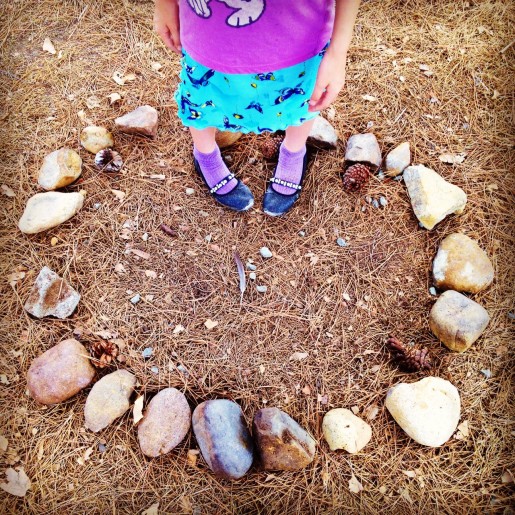
Our insanely busy summer is winding down, and soon we’ll be back to just regular busy. Jane took the week off her internship because she landed a short-term gig at a community college bookstore—the very college at which Rose is now taking a Spanish class, though the store is not on campus. Nearby, though, and Scott’s and my taxi powers have not been, er, overtaxed. (Ba dum bump.) And only three doctor visits in the past two weeks: one long scheduled, one unanticipated, and one follow-up. Considering the records we set earlier in the summer, this tally is positively yawnworthy.
(I just peeked at next week’s calendar, and there are NO. APPOINTMENTS. SCHEDULED. Which means somebody will probably break an arm.)
(Not funny, Lissa.)
With Wonderboy back in school and Rose uttering heretofore unuttered phrases like “Here’s my syllabus if you want to take a look” and “I finished my homework” (!), we find ourselves comfortably returning to our high-tide rhythms—with a few innovations this year. I’ve marked out blocks of time (cleverly called Block 1 and Block 2, which has my inner Anne Shirley rolling her eyes in disgust) to focus on Rose and Beanie (1) or Huck and Rilla (2) with some planning and deliberation. That is, I want to make sure we get to the Fun Stuff and the Important Stuff, and I’ve set aside time for the purpose. Four nice chunks of Block 1 and three of Block 2 each week, tucked into specific corners of the day.
Today’s our third day, and so far I’m tickled pink. Yesterday afternoon ended with Huck and Rilla literally climbing on top of me, chanting “More Block 2! More Block 2!” One excellent development is that Rilla and I now have a dedicated time to work on art projects. She picked this toucan painting to start with, and to my amusement I was not merely expected to facilitate her efforts: I was required to undertake a painting of my own. Our works are coming along nicely. Today we put in the skies.
Also chalked in on the schedule is a regular park visit, an extremely important addition in the eyes of my younger children. Huck and Rilla anticipated today’s outing all week long. Finally the appointed hour arrived—and thirty seconds after hitting the playground, all three of us melted into puddles from the fierce heat. Cue general despondency. In times like this, there’s only one thing to be done: find a shady nook under the fringe of pine trees and build ourselves a Roxaboxen. We each made our own little round houses with a nice path connecting them. We’re all in suspense to see what will be left of our realm next week.
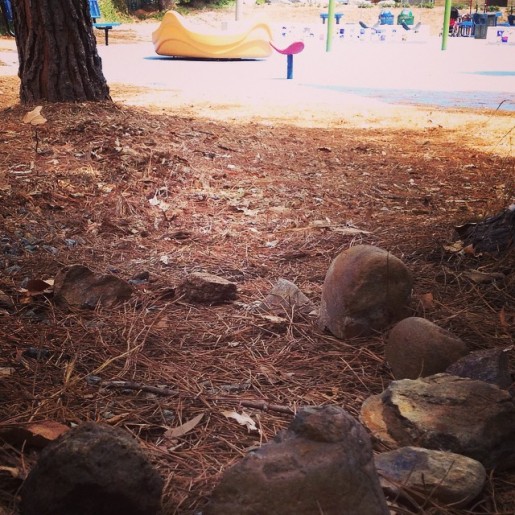
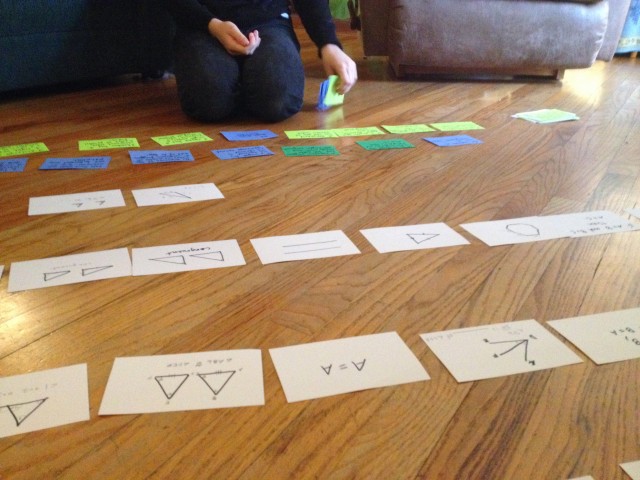
The weekend: Jane headed back to college, the rest of the kids succumbed one by one to a fairly-short-lived-but-obnoxious-in-the-short-term cold, and I cleaned house all day Saturday to avoid finishing my taxes. And then gardened all day Sunday to avoid same. Did not read much, in part because sitting still and doing something besides taxes was harder to justify than, say, scrubbing floors or mowing the lawn. I mean, I can’t possibly be faulted for procrastinating going through expense receipts when I’m washing walls, can I? You guys, I was even washing walls. My ability to be intensely industrious at all the wrong tasks is unparalleled.
Monday: all but one of the kids have kicked their cold. We’re still in high tide, have got a very groovy groove going, in fact. Rose, Beanie, and I are all enjoying the books we’re reading together, and Latin has been really fun lately. Also, it happened that the episode of Cosmos everyone watched the night before Jane left was all about Sir Isaac Newton, about whom we’ve been reading in The Story of Science. Extremely considerate of the show to time things so conveniently.
I’ve been getting some questions about scheduling lately, both from real-life friends and blog readers, and since I’ve completely dropped the ball on my separate homeschooling blog (if you’ve asked for the login info and I haven’t replied, it isn’t that you’re not welcome; it’s simply that I’ve dropped that ball too, and I haven’t posted there in weeks anyway so you aren’t missing a thing…but feel free to ping me again for the info!) maybe I can give a quick sketch here of a “typical day”—of course we all know there isn’t any such thing, really; they’re all a little different. But we do keep the same rough structure four days a week. The fifth day, which falls in the middle, is for piano lessons and errands and (for Beanie) volunteering at Wonderboy’s school.
6:30ish—the boys wake up, Scott turns on a show for them to watch.
7am—Scott and I get up (sometimes he’s up already). He fixes breakfast for the boys and cocoa for me, and I take my laptop to the couch where the lads are watching their show. Email, etc while I come alive.
7:35—supposed to be 7:30 but I always push it as long as possible. I get up to get dressed, put my contacts in, pack Wonderboy’s lunch. By now he has already gotten dressed and getting ready for school.
8am—I’m in my bathroom brushing my hair and I hear the first bell ring on the other side of our back fence. I jump into my shoes and walk WB around the corner just in time for school.
8:15 (is this too granular? LOL)—I’m back home and now Scott and I leave for our walk. Beanie and Rilla are by now up and dressed (well, Beanie’s dressed), finished with breakfast most likely, and the TV is off. Rose waits for us to leave before dragging herself out of bed. Usually someone is playing piano when we leave and someone else is playing when we get back.
8:45ish—the teens have done their morning chores, Scott and I are back home after our walk (we call it our daily staff meeting), and I grab a yogurt and Scott makes a cup of coffee and we drift to our separate computers to eat/drink/read.
9am sharp—Scott starts work, back in the boys’ bedroom, which doubles as his office during the day. Rilla will likely spend the next hour puttering through her morning chores, which are few and simple but easily interruptible, it seems. Huck is dressed and running around. Mostly he’s counting down the minutes until 9:30, when (after two rounds of breakfast) he gets a snack. Rose and Bean join me in the living room for our lesson time. Now, the sequence of the next 3 hours varies day by day, but here was today’s. 9:00, we started with Poetry. First Poetry 180, two poems today because after we’d read Roethke’s “The Bat” they saw what came next and remembered especially liking that one when we did a chunk of this series with Jane, a couple of years ago: Tom Wayman’s “Did I Miss Anything.” Then John Donne, Meditation XVII (No man is an island…), in our continuing exploration of the metaphysical poets.
9:30? more or less?—Story of Science, the Newton chapters continued. I read aloud, we discuss. 1666, “The Year of Wonders” (Dryden’s Annus Mirabilis designation for the year of the Great Fire, which later came to be applied by scientists to that same year when Newton developed his theory of gravitation, oh and invented calculus, oh and figured out about color and light—that little old year), is a perfect choice for one of our history cards. Have I talked about this here, or only on Facebook? It’s pretty much the most successful idea I’ve ever had, history-wise. We used to keep a giant timeline on one wall, but in this house there’s no perfect spot for it; it was up too high; we never added anything new. A couple of months (?) ago, on a whim, I grabbed index cards and started writing down events or people we’d been reading about, in all our various books. Science stuff, history, literature, music, art, anything I could think of that we’d recently discussed. Person or event on the front, the year on the back. We have had such fun with these cards! Once or twice a week we play a game with them—Rose likes the competition—where I hold up a card and the girls take turns calling out the date and arranging them in sequence. We’ve all nailed down a great many dates that were quite fuzzy even for me before. My original goal was simply to have them be able to identify events in rough sequence, and there were only a few major dates I said they had to absolutely memorize. But the game has hammered nearly all the dates into our heads, mine included. And the cards themselves provide an excellent record of what we’ve studied, and how the different eras we’ve read about this year (19th century American history, Renaissance science, Elizabethan literature) fit together. We’ll be able to keep on adding to the stack: a game without end. Rose was pretty lukewarm on history before, and now she says she wants to minor in it at college.
Anyway, no cards today, I just got onto the subject because we remarked upon 1666 as an important year to make a card for.
All right, so now it’s around 10am, I think?—or a little before? I think next we did math. Beanie watched a MUS video and since Rose didn’t remember that bit, she watched too. By now Rilla and Huck are outside playing, having consumed their snack. Rose likes me to go over the new lessons with her, so we did that. She’s only got two more in this book (geometry), hurrah! (We made cards for geometry last week, too, since she has found them so useful for history. Wrote out all the postulates and properties, with matching cards containing examples. And one very cool thing was that after she’d spread them all out and matched them up, we realized she’d just done all of geometry right there. I mean, all of it that’s covered in this book. The last few lessons are a preview of trig. It was gratifying for her to see the scope of her accomplishment.)
Beanie didn’t need help with her math, so once Rose got on to working her problems, I went out to mow the front lawn. Beanie finished and practiced piano.
10:30—Rilla and Huck went in to get their half-hour on the iPad. I usually reserve this for when I’m reading with the older girls, but today I was still finishing the yard. Rose finished math and did some Memrise.
11am—littles are off iPad, back to playing. Rose downloaded a metronome she needs for a song she’s learning in 5/4 time, but I don’t think she had much time to practice before I called her for the next thing. (She plays for a good bit most afternoons while I’m working, though.) Beanie did 15 minutes of freewriting while I read through a lesson with Rose in an essay-writing book we’re going through. Then Rose went to do the exercise for that chapter while I looked over Beanie’s freewrite.
11:30.—Latin with all three girls. We’ve been using a different book for new vocab but right now we’re using the rather old Latin Book One for some real reading and translation practice. We’re all really enjoying this.
12pm.—Lunch. Huck begged to watch Ponyo. Generally we don’t do any TV or videos at this time of day, but he’s been on a real Ponyo kick lately and was still getting over that cold, so I said yes. He ate his lunch and then fell asleep on the couch, watching the movie. I sat on the front stoop with Rilla, doing a subtraction lesson. Then she went in to eat, and Rose was eating, and Beanie had already finished. Bean and I went into the backyard and dug out a dead plant, and talked about Romeo and Juliet, which she was about to begin reading.
12:30ish?—Somewhere in there, I ate my own lunch. Then Rose and I started Gulliver’s Travels. I gave a bit of background and we read the first chunk together. She’ll continue on her own, but she really likes doing things in tandem. Beanie was reading R&J by this time, and Rilla was doing magical Rilla things.
1:15pm—Rilla’s turn. She was itching to garden, because Mary Lennox. We weeded the front-yard flowerbed and found a snail. After about a half hour, we were both hot and thirsty. Went in for a drink and then read two chapters. Met Dickon! The roses are wick!
2:30—time to pick up Wonderboy. Rilla walked with me, Huck was just waking up. Got home, unpacked, Beanie was doing her afternoon tidy and Rose had the dishes ready. I wash, she rinses. Wonderboy and I chatted, and then he turned on Word Girl.
3pm—Scott came out, and it was time for me to go to work.
Things unusual about this day:
• the Ponyo viewing and Huck’s nap, which meant I didn’t read to him at all!
• gardening with Rilla and reading an extra chapter of Secret Garden meant I didn’t do any of my own reading, which I usually try to squeeze in during the last half hour before Wonderboy gets home. But then I never read as much in spring, do I?
• Most mornings, Rilla sets up camp at the kitchen table with all her drawing supplies while I’m reading to her sisters. She absorbs quite a lot of history and lit that way.  But today she was very busy with Huck all morning.
But today she was very busy with Huck all morning.
• No German for Beanie, and barely any piano time for Rose. Usually Rose is pounding away every time I turn around. She likes short bursts of practice throughout the day, whereas Beanie will sit down for one long concentrated session.
I imagine any day I picked for this exercise would have about the same number of (totally different) “things that are different about this day.” An orthodontist appointment, a Journey North meeting, a muddy little boy in need of a bath.
 KidLitReviews:
KidLitReviews:
I really messed up today’s post. Not an easy to do on WordPress, but I always was exceptional at messing up things that were not supposed to be messable. So, instead of my gibberish today. check out this “Choose Your Own Adventure” story by two young boys. The story begins on the boys’ website, Story Boys blog. Third-grader T. Isenhoff and his brother, sixth-grader M. Isenhoff wrote this story as part of their homeschooling curriculum. Mom Michelle helped a little and should be very proud of her two scribes. Enjoy!
 Originally posted on Story Boys:
Originally posted on Story Boys:
We are so excited to present our recent homeschool writing project–a Choose Your Own Adventure story! We have 14 blogging friends helping to make this happen. (Thanks so much, everyone!) Here’s what you do: Start reading here on Storyboys. At the end of our page, YOU have to decide how the story will go. Each choice will lead you to a new blog. Altogether you will make three choices and land on one of eight endings. Of course, when you’re done you can always come back here and start again, making different choices. Have fun!
(A note from T-man and M-man: We created the characters, the setting, and all the plot events. Mom asked us lots of questions and we had to answer them. We had to keep track of all the choices on a posterboard. Then Mom typed out the story while we helped her know what to write. It…
View original 421 more words
Filed under:
5stars,
Children's Books,
Interesting Links,
Special Event Tagged:
choose-your-own-adventure-story,
homeschooling,
Isenhoff kids,
Michelle Isenhoff 







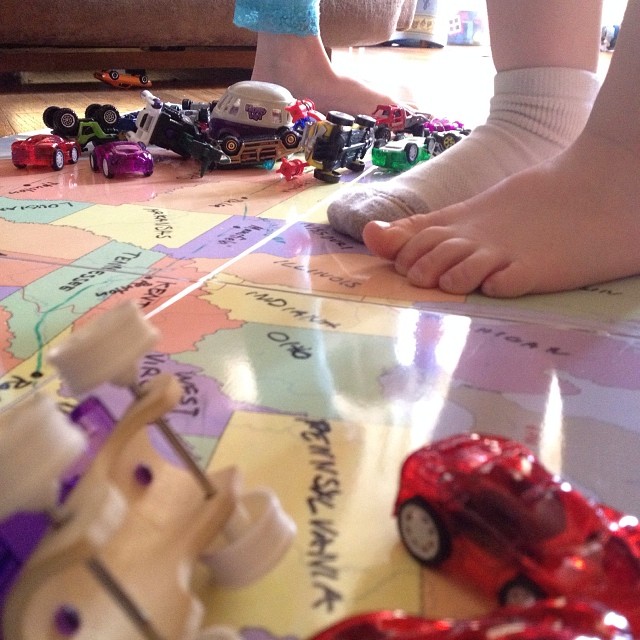
Some quick notes on things we’re using a lot lately:
• Spellosaur app (Rilla and Huck). With the paid version, you can enter lists of spelling words for each kid. They both ask to play it daily, which is fine by me.  Huck’s favorite part is recording his own audio for the words, which he then laughs at on playback during the activities. I wouldn’t normally be working on spelling with a five-year-old but he enjoys the app so much, it isn’t work. For Rilla, I’ve been entering word lists from an old copy of Spelling Power. She also created a second user account to use for French words. Here, too, she loves recording the audio herself.
Huck’s favorite part is recording his own audio for the words, which he then laughs at on playback during the activities. I wouldn’t normally be working on spelling with a five-year-old but he enjoys the app so much, it isn’t work. For Rilla, I’ve been entering word lists from an old copy of Spelling Power. She also created a second user account to use for French words. Here, too, she loves recording the audio herself.
• I couldn’t find our Chronology game (I know it’s around here somewhere), but Rose and Beanie have been absorbing a lot of history this year, in a jumble of time periods. Science history in the Renaissance, American history between the Revolutionary and Civil Wars, medieval English literature (now heading into Renaissance there too), all sorts of non-coordinated reading going on. We took our old timeline down last year—it was up too high and we weren’t really adding to it anymore—and I wanted some way to make chronological sense of all these events they’re soaking up. So I had a brainstorm and made our own custom Chronology set, sort of. We got index cards and wrote various key events and people on them, with a little stripe of colored highlighter on one side to indicate science, literature, arts, or political history.* They put the dates on the back of each card. We play the game just like Chronology: I put down one starter card and then they take turns calling out the date of the next event, and putting it down in a row in chronological order. If we can keep it up, we’ll build a nice collection of the main points of our history/science/literary studies this year. They get pretty giggly and competitive in the game, so it’s been way fun so far.
*A fifth color denotes fictional works related to a period we’re studying. There are certain novels and films that will always represent a particular time and place—Betsy in Spite of Herself, for example, popped immediately into the girls minds when we read about German immigrants building a home away from home in Milwaukee.
• The other thing we do quite a lot in our history studies is link whatever we’re reading about to our own family history, as far as we’re able. This applies mostly the 18th century and on, of course (although we do have a couple branches on the family tree traced back to the 16oos). I like to pull up our tree on Ancestry.com and take a look at who among our ancestors was living in a particular area at a given point in time. The big waves of Irish and German immigration in the first half of the 19th century, for example, became much more vivid to the girls when they got a look at the names and disembarkation dates of their forebears who were among those masses.
Quick note to say I’ve updated my Tidal Homeschooling page. Are there any questions or topics you’d like me to tackle?

By:
Jen Robinson,
on 1/9/2014
Blog:
Jen Robinson
(
Login to Add to MyJacketFlap)
JacketFlap tags:
Reviews,
friendship,
middle grade fiction,
homeschooling,
farm life,
chickens,
Newsletter,
Late Elementary School,
female protagonist,
Add a tag
Book: Prairie Evers
Author: Ellen Airgood
Pages: 228
Age Range: 8-12

 Prairie Evers by Ellen Airgood is a middle grade novel about a year in the life of a ten year old girl who is adjusting to her family's move from North Carolina to upstate New York, where her mother grew up. Prairie's first person tale begins on New Year's Eve, when she learns that her beloved Grammy has decided to move back to North Carolina. Lonely, Prairie decides to start raising chickens (and one rooster, it turns out).
Prairie Evers by Ellen Airgood is a middle grade novel about a year in the life of a ten year old girl who is adjusting to her family's move from North Carolina to upstate New York, where her mother grew up. Prairie's first person tale begins on New Year's Eve, when she learns that her beloved Grammy has decided to move back to North Carolina. Lonely, Prairie decides to start raising chickens (and one rooster, it turns out).
When fall comes, Prairie, who was previously homeschooled by Grammy, is sent to school for the first time. Prairie's dark skin (she is part Cherokee Indian), southern accent, and thirst for knowledge all mark her as different, and she finds herself at the bottom of the school's pecking order. But she soon learns that having just one friend can make all the difference in the world.
What made Prairie Evers work for me was the delight that is Prairie's voice, with its combination of down-home Southern accent and occasional advanced vocabulary. Here are a couple of examples, but honestly, the whole book is like this:
"Then I ducked my head and hoped the Lord would not strike me down. Mama's folks had perished in a car accident, and it was very tragic. I knew that the way you know something in your head, but I always felt guilty I didn't feel it more in my heart. But the thing was, I never really knew them." (Page 3)
"You could have knocked me over with the smallest, downiest chicken feather. I could not imagine a worse idea. Mrs. Perkins's kids back home went to school and they'd told me plenty about it. In school you were trapped inside all day, and you had to sit still in a chair, and you had to learn by memorizing textbooks instead of reading all the interesting books Grammy used with me." (Page 62)
"I scowled with my whole entire self." (Page 64)
I love fish out of water stories, and I found Prairie's social struggles in school to be realistic. Besides her one friend, there's no magic bullet that results in her suddenly being accepted (though bringing a rooster to school turns out to be a step in the right direction). I also like the way Prairie Evers highlights advantages and disadvantages of both homeschooling AND traditional schooling, without judgement one way or the other.
There's also a wonderful bit later in the book in which Prairie comes to understand that although she loves her friend Ivy, the two girls think differently about things, and have different strengths. Prairie Evers is a book that quietly shows kids (without preaching) that it's ok for people to be different, and that kindness will often be noticed and appreciated.
None of the other characters, including Ivy, are as fully fleshed out as Prairie (though some of the chickens are pretty interesting). But Airgood does tackle other issues besides Prairie's missing Grammy and adjusting to school. There's Prairie's mother's re-introduction to a judgmental community, after a wild youth, as well as Ivy's unhappy home life. Prairie's parents' financial struggles are also treated openly (they live by making crafts and selling them at local farmer's markets). But it's still clear, despite not having a lot of money, that Prairie and her parents consider themselves pretty lucky.
All in all, Prairie Evers is a breath of fresh, country air. It reminds me a bit of Linda Urban's Hound Dog True, and a bit of Jill Alexander's The Sweetheart of Prosper County. But really, Prairie is entirely herself, unique and likeable and sure to be appreciate by any 8-12 year old (particularly girls). Recommended, particularly for elementary school library purchase.
Publisher: Nancy Paulsen Books (@PenguinKids)
Publication Date: May 24, 2012
Source of Book: Review copy from the author
FTC Required Disclosure:
This site is an Amazon affiliate, and purchases made through Amazon links (including linked book covers) may result in my receiving a small commission (at no additional cost to you).
© 2013 by Jennifer Robinson of Jen Robinson's Book Page. All rights reserved. You can also follow me @JensBookPage or at my Growing Bookworms page on Facebook.

This is a quick-and-dirty list of homeschooling how-to and reference books I’d love to see in libraries. I’ll prettify it later. Throwing it up hastily now during #ReadAdv and will probably add to it during the discussion.
Charlotte Mason’s Original Homeschooling Series
Sandra Dodd’s Big Book of Unschooling
Year of Learning Dangerously by Quinn Cummings.
Free Range Learning by Laura Grace Weldon
Project-Based Homeschooling by Lori Pickert
The Unschooling Handbook by Mary Griffith
From Liz Burns re the #ReadAdv Twitter chat for librarians and interested parties:
Our next chat takes place on Thursday, December 5 at 8 P.M. EST.
Sophie and Kelly and I were tossing around possible topics for our next chat, and homeschooling came up. Seems like librarians are always asking about and wondering about working with homeschoolers. What can they do? What should they do? What works?
So I said, oh, we should have guests. And I had a short dream list of possibilities: the two people who, in talking about homeschooling, makes me want to have kids just so I can homeschool them.
They are, of course, Melissa Wiley and Quinn Cummings. And both these terrific women said YES. So Melissa Wiley (@melissawiley on Twitter) and Quinn Cummings (@quinncy) will be joining us on December 5.
Got anything you’d like me to share with librarians who are wondering how best to serve homeschoolers? Wish lists, etc? Send me your questions and I’ll share them this evening, 8pm EST, 5pm here on the West Coast. Follow #ReadAdv to see the discussion unfold.

By:
Jen Robinson,
on 11/5/2013
Blog:
Jen Robinson
(
Login to Add to MyJacketFlap)
JacketFlap tags:
Reviews,
Picture Books,
homeschooling,
Newsletter,
diane degroat,
ranch life,
the pioneer woman,
ree drummond,
charlie the ranch dog,
Add a tag
Book: Charlie Goes to School
Author: Ree Drummond (@ThePioneerWoman)
Illustrator: Diane deGroat
Pages: 40
Age Range: 4-8

 I like Ree Drummond's series about lazy ranch dog Charlie (see my previous reviews of Charlie the Ranch Dog and Charlie and the Christmas Kitty). In the newest installment, Charlie maintains his self-deceptive laziness ("I'm helping, of course" as he snoozes away near a project) as the ranch family begins their new school year. There's not actually much in the way of plot to Charlie Goes to School. It's more of an introduction to the joys of homeschooling, on top of the recurring gag of Charlie's self-absorption.
I like Ree Drummond's series about lazy ranch dog Charlie (see my previous reviews of Charlie the Ranch Dog and Charlie and the Christmas Kitty). In the newest installment, Charlie maintains his self-deceptive laziness ("I'm helping, of course" as he snoozes away near a project) as the ranch family begins their new school year. There's not actually much in the way of plot to Charlie Goes to School. It's more of an introduction to the joys of homeschooling, on top of the recurring gag of Charlie's self-absorption.
Still, considering the vast number of picture books that take place in traditional schools, it's nice to see one dedicated to homeschooling. The text is matter-of-fact, without getting into any reasons why one might homeschool. Just:
"Lots of kids go to school at school, and lots of kids go to school at home."
The focus remains on Charlie, of course, rather than on the kids, but we still get a look at reading time, creative math (subtraction via animal crackers) and recess. And when Charlie decides to homeschool the other animals on the ranch, gentle laughs are had by all.
Drummond's text and Diane deGroat's illustrations are tightly coupled here, with the whole story only apparent when both are considered together. Like this:
"Kitty Kitty needs to practice his math. Numbers are very important when it comes to counting food." (Picture of Kitty knocking animal crackers on the floor.) "DON'T PLAY, KITTY KITTY. COUNT!"
or
"The ranch horses need to brush up on their history." (Picture of a horse attempting to lift a book with his mouth.) "EXCUSE ME! BOOKS AREN'T FOR EATING!"
Charlie's melodrama when talking with the other animals should make this a fun read-aloud. I could see "EXCUSE ME! BOOKS AREN'T FOR EATING!" becoming a household catchphrase in our home. Fans of Charlie the Ranch Dog will certainly want to take a look at Charlie Goes to School. Homeschooling families will also want to check this one out (making it a recommended purchase for public libraries).
Publisher: HarperCollins (@HarperChildrens)
Publication Date: June 25, 2013
Source of Book: Review copy from the publisher
FTC Required Disclosure:
This site is an Amazon affiliate, and purchases made through Amazon links (including linked book covers) may result in my receiving a small commission (at no additional cost to you).
© 2013 by Jennifer Robinson of Jen Robinson's Book Page. All rights reserved. You can also follow me @JensBookPage or at my Growing Bookworms page on Facebook.

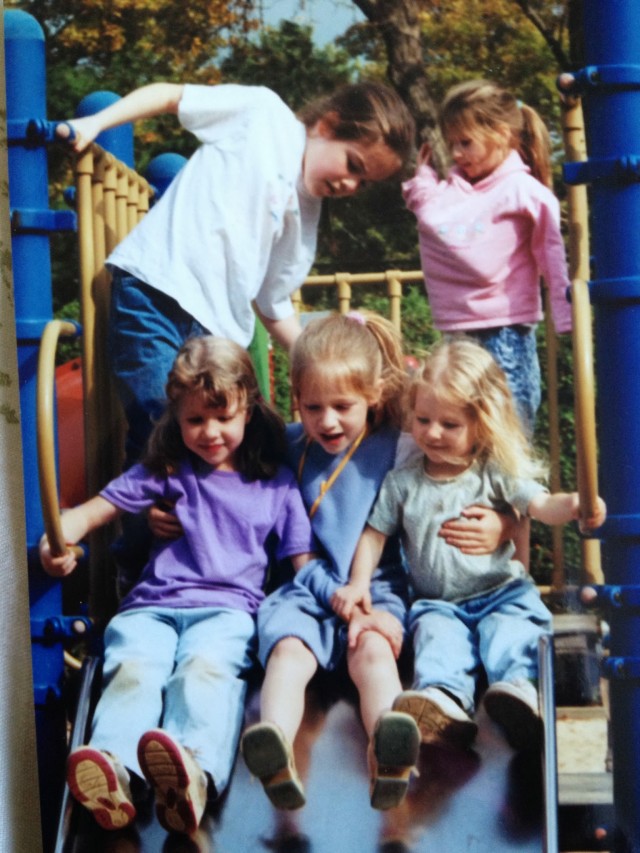
Sent this picture to Alice the other day because I knew it would get her the way it got me. She pointed out that four out of five of these girls are in college now. Well, almost! Jane moves in next week.
She was barely a month old when I decided I wanted to homeschool her. I’d been poking around the AOL parenting boards (having obtained my first modem and my first baby within six weeks of each other) and stumbled upon the Home Education Magazine boards. Before long I was devouring back issues of Growing Without Schooling and amassing a collection of Holt and Gatto books. Sandra Dodd and Pam Sarooshian were among the moms-of-youngish-kids enthusing about unschooling there, using the word in the broad Holtian sense, living and learning outside school. By the time Jane was six months old, Scott was on board, with reservations. They dissolved over the next year or two, as we talked and talked and read and read (well, I read and talked, he mostly listened). Really, the notion had me at hello.
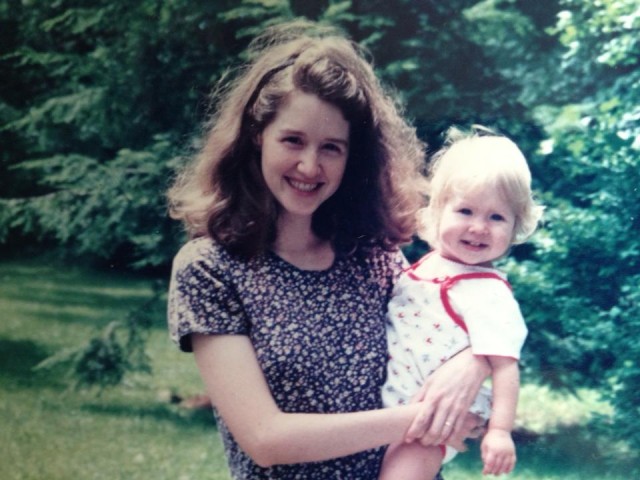
It felt right for us, and it kept on feeling righter and righter, all these past eighteen years. When Jane was five, finally finished with her cancer treatments, an early and voracious reader, addicted to the Magic Tree House books, I hung a sheet of butcher paper the length of our hallway and we pasted little copies of the book covers in the pertinent time periods. We still have that timeline, now ripped here and there and crammed with tidbits. It was on the wall in this house until last year; it comes and goes as the urge hits us. There in large wobbly letters are young Jane’s notations: “Golden Age of Pirates,” “Charlemagne,” “King Alfred BURNED THE CAKES!!!”

Back up to when she was—around four? Alice will remember—we’re in an educational supply shop, Alice, her small girls (two of them on the slide above), Jane, probably a couple of babies. We’re browsing at a placemat spin rack. I put a few in my cart: planets, U.S. map, presidents. On the next aisle, I drop something else in and discover a placemat I hadn’t selected: the periodic table of the elements. Seems a bit early for that. I put it back. But a minute later, I glance in the cart and there it is again. I’m perplexed. “Did you put this in?” I ask my wee daughter. She nods. I’m taking it out to return it to the rack, we have enough in the cart already, and she bursts out earnestly: “But Mommy! I need to learn about the EE-laments!”
(Sold. We still have that placemat.)
One year I was speaking at a homeschooling conference, and the teenage daughter of my boothmate took Jane—again around age four or five—to the drinking fountain. She reported back that when Jane saw the water arc out of the spout, she exclaimed over getting to drink a rainbow. Took a drink. Frowned, puzzled. “Funny. I always thought rainbows would be crunchy.”
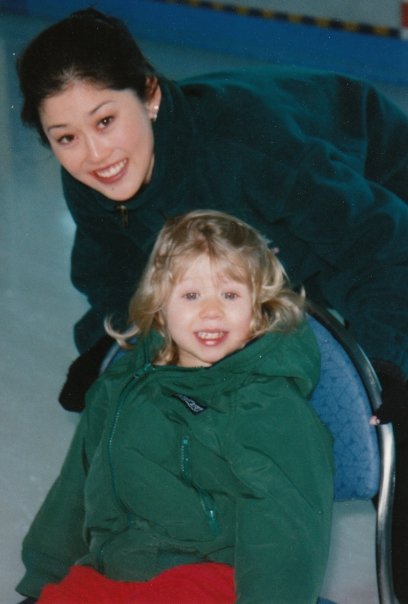
She so often surprised me with the knowledge she’d absorbed from I knew not where. Scooping something out of water one day (had the baby dropped Cheerios into Jane’s cup? it was something like that), she—again age four or five, those are very bright memories for me—remarked that her fingers were like a whale’s baleen. I didn’t know what baleen meant, but luckily I had Jane to enlighten me.
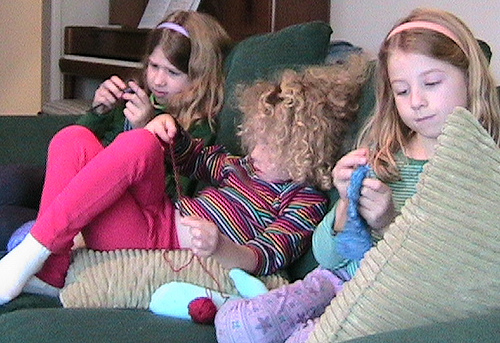
The year she was eight, we read our way through a tower of America-themed historical fiction. Witch of Blackbird Pond, Moccasin Trail, By the Great Horn Spoon, Understood Betsy, whole bunch of others. That was a fabulous year. We were in our big house in Virginia then, with the propane fireplace you flipped on with a switch. That thing drew me like a magnet. I’d stand there toasting myself, reading aloud while the snow fell heavy on the hills and the juncos hopped beneath the feeder, and Jane lolled on the sofa with Beanie banging dents into my cedar chest with Wedgits—the first in a line of babies to bash away at that spot. Its entire surface is pockmarked with enthusiasm and glee. Sort of the best-loved-doll of furniture.
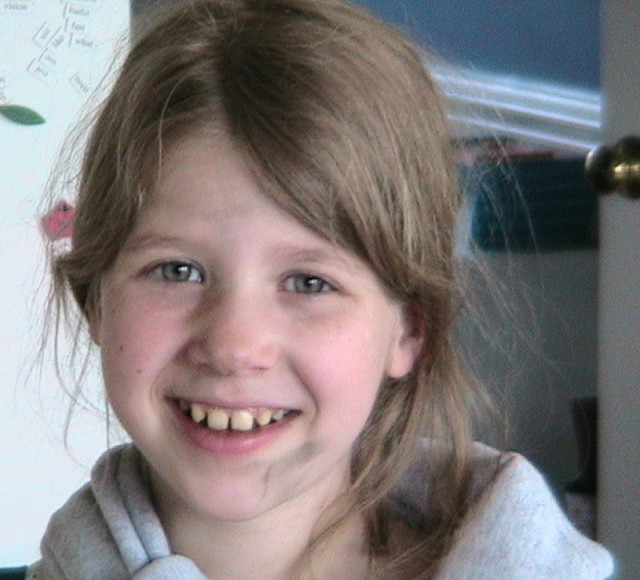
Project Feederwatch. Journey North Mystery Class. Shakespeare Club. Piano Guild. Film Club. Living Earth School—a nature camp in the Blue Ridge Mountains where Jane learned to make fires, to eat violets and chickweed. She had sold all the kids on our street on the virtues of chickweed for iron and violets for vitamin C, and they’d comb our yard, nibbling weeds until their teeth were green. I delivered a hasty lecture about pesticide and lawn fertilizer, and extracted a promise that the kids would only eat from our lawn, because I couldn’t be sure the others were chemical-free.
And that weed book! I blogged about this years ago: “Two summers ago I wanted to know what was growing in our unlandscaped side yard, so I checked a book on weeds out of the library. I glanced at it but decided this book was too dry to make it worth the effort and tossed it onto the kitchen table. The next day I returned it to the library. The next day, then-7-year-old Jane summoned me with an anguished wail. ‘Mommy, where’s that great book I was reading? The one about weeds? It was SO interesting!’ She’d found it lying on the table and naturally assumed that it was meant for her. I admitted I’d returned it, and she was crushed. I had to promise to schedule a special trip to re-check it out.”
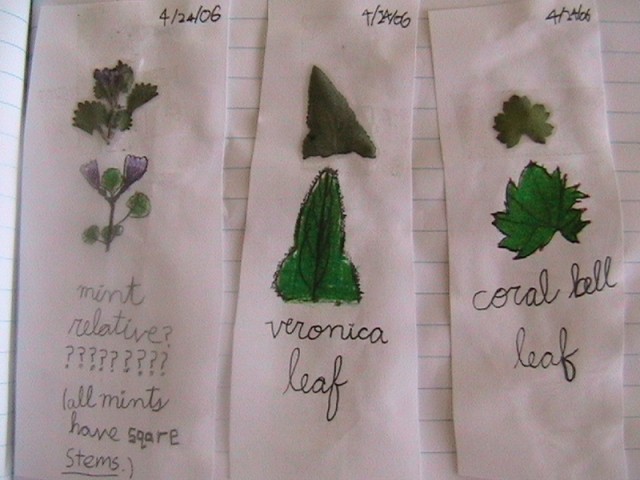
Through high tide and low tide, we’ve learned a million things together. And now she’s heading off to go on learning somewhere else, and I couldn’t be more grateful, and more excited for all the adventures she has ahead of her.
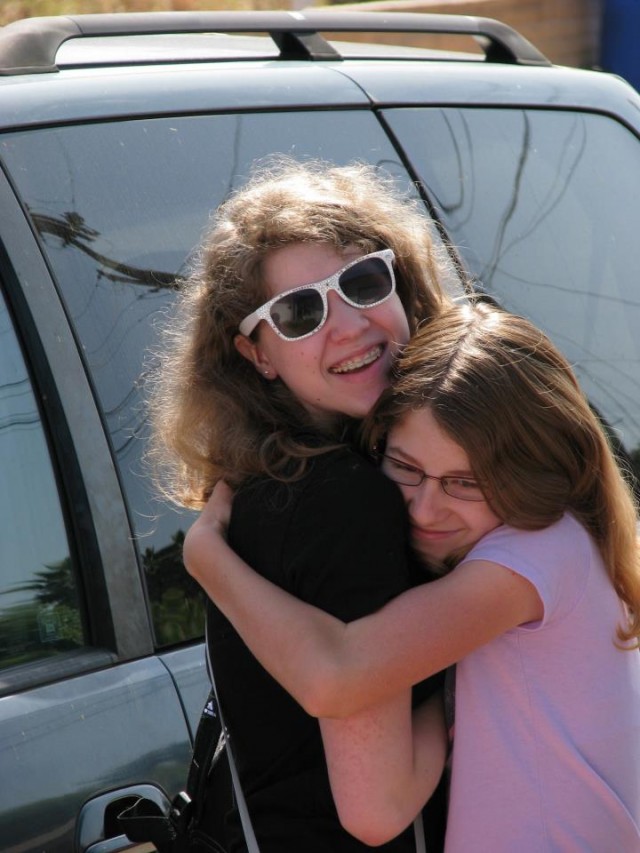

Sent this picture to Alice the other day because I knew it would get her the way it got me. She pointed out that four out of five of these girls are in college now. Well, almost! Jane moves in next week.
She was barely a month old when I decided I wanted to homeschool her. I’d been poking around the AOL parenting boards (having obtained my first modem and my first baby within six weeks of each other) and stumbled upon the Home Education Magazine boards. Before long I was devouring back issues of Growing Without Schooling and amassing a collection of Holt and Gatto books. Sandra Dodd and Pam Sarooshian were among the moms-of-youngish-kids enthusing about unschooling there, using the word in the broad Holtian sense, living and learning outside school. By the time Jane was six months old, Scott was on board, with reservations. They dissolved over the next year or two, as we talked and talked and read and read (well, I read and talked, he mostly listened). Really, the notion had me at hello.

It felt right for us, and it kept on feeling righter and righter, all these past eighteen years. When Jane was five, finally finished with her cancer treatments, an early and voracious reader, addicted to the Magic Tree House books, I hung a sheet of butcher paper the length of our hallway and we pasted little copies of the book covers in the pertinent time periods. We still have that timeline, now ripped here and there and crammed with tidbits. It was on the wall in this house until last year; it comes and goes as the urge hits us. There in large wobbly letters are young Jane’s notations: “Golden Age of Pirates,” “Charlemagne,” “King Alfred BURNED THE CAKES!!!”

Back up to when she was—around four? Alice will remember—we’re in an educational supply shop, Alice, her small girls (two of them on the slide above), Jane, probably a couple of babies. We’re browsing at a placemat spin rack. I put a few in my cart: planets, U.S. map, presidents. On the next aisle, I drop something else in and discover a placemat I hadn’t selected: the periodic table of the elements. Seems a bit early for that. I put it back. But a minute later, I glance in the cart and there it is again. I’m perplexed. “Did you put this in?” I ask my wee daughter. She nods. I’m taking it out to return it to the rack, we have enough in the cart already, and she bursts out earnestly: “But Mommy! I need to learn about the EE-laments!”
(Sold. We still have that placemat.)
One year I was speaking at a homeschooling conference, and the teenage daughter of my boothmate took Jane—again around age four or five—to the drinking fountain. She reported back that when Jane saw the water arc out of the spout, she exclaimed over getting to drink a rainbow. Took a drink. Frowned, puzzled. “Funny. I always thought rainbows would be crunchy.”

She so often surprised me with the knowledge she’d absorbed from I knew not where. Scooping something out of water one day (had the baby dropped Cheerios into Jane’s cup? it was something like that), she—again age four or five, those are very bright memories for me—remarked that her fingers were like a whale’s baleen. I didn’t know what baleen meant, but luckily I had Jane to enlighten me.

The year she was eight, we read our way through a tower of America-themed historical fiction. Witch of Blackbird Pond, Moccasin Trail, By the Great Horn Spoon, Understood Betsy, whole bunch of others. That was a fabulous year. We were in our big house in Virginia then, with the propane fireplace you flipped on with a switch. That thing drew me like a magnet. I’d stand there toasting myself, reading aloud while the snow fell heavy on the hills and the juncos hopped beneath the feeder, and Jane lolled on the sofa with Beanie banging dents into my cedar chest with Wedgits—the first in a line of babies to bash away at that spot. Its entire surface is pockmarked with enthusiasm and glee. Sort of the best-loved-doll of furniture.

Project Feederwatch. Journey North Mystery Class. Shakespeare Club. Piano Guild. Film Club. Living Earth School—a nature camp in the Blue Ridge Mountains where Jane learned to make fires, to eat violets and chickweed. She had sold all the kids on our street on the virtues of chickweed for iron and violets for vitamin C, and they’d comb our yard, nibbling weeds until their teeth were green. I delivered a hasty lecture about pesticide and lawn fertilizer, and extracted a promise that the kids would only eat from our lawn, because I couldn’t be sure the others were chemical-free.
And that weed book! I blogged about this years ago: “Two summers ago I wanted to know what was growing in our unlandscaped side yard, so I checked a book on weeds out of the library. I glanced at it but decided this book was too dry to make it worth the effort and tossed it onto the kitchen table. The next day I returned it to the library. The next day, then-7-year-old Jane summoned me with an anguished wail. ‘Mommy, where’s that great book I was reading? The one about weeds? It was SO interesting!’ She’d found it lying on the table and naturally assumed that it was meant for her. I admitted I’d returned it, and she was crushed. I had to promise to schedule a special trip to re-check it out.”

Through high tide and low tide, we’ve learned a million things together. And now she’s heading off to go on learning somewhere else, and I couldn’t be more grateful, and more excited for all the adventures she has ahead of her.

…just how much this kid loves Paddle-to-the-Sea.
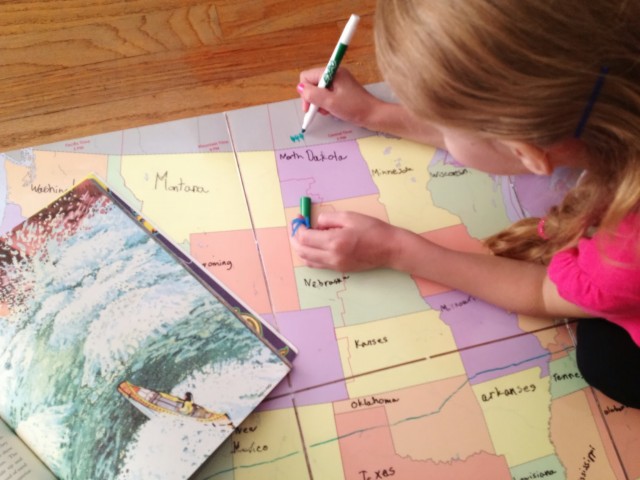
“A bumpy line of buildings stretched like castles along the horizon. They were grain elevators at Port Arthur and Fort William filled with mountains of grain which trains had brought from the plains of western Canada. The ships now passing Paddle would carry the grain to other lake ports and other lands…”
(She decided to draw stalks of wheat to represent the grain. She’s charting Paddle’s journey through the Great Lakes in blue.)
By:
Donna Earnhardt,
on 9/5/2013
Blog:
WORDS
(
Login to Add to MyJacketFlap)
JacketFlap tags:
kids,
school,
teaching,
rants,
students,
homeschooling,
class,
homeschool,
writing for children,
concord,
concord nc,
homeschool in NC,
homeschool teachers,
public school,
NC,
homeschooling in NC,
NCDNPE,
Add a tag
I have had several conversations lately about the state of homeschooling in our lovely state of NC. And as a homeschooling mom, I am more than glad to discuss this issue with anyone who asks. Here are a few things to help answer any questions in case more folks want to know: 1. I homeschool […]
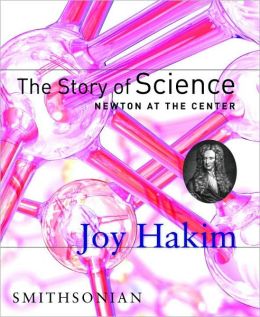 The Story of Science: Newton at the Center by Joy Hakim. Our history spine for the high-tide parts of our year. Yup, history: Hakim’s Story of Science series takes a historical-biographical approach to science, tracing the development of ideas in the context of the lives of the great thinkers and scientists, and the cultural and political events surrounding them. This is book two in the three-part series, beginning in the 1450s: the printing press, the fall of Constantinople. My heart goes all pitty-pat when I think about some of the books I can pull off the shelves this year to go along with this one: The Apprentice by Pilar Molina Llorente; The Second Mrs. Giaconda; Twain’s Joan of Arc; Diane Stanley’s Michelangelo for starters.
The Story of Science: Newton at the Center by Joy Hakim. Our history spine for the high-tide parts of our year. Yup, history: Hakim’s Story of Science series takes a historical-biographical approach to science, tracing the development of ideas in the context of the lives of the great thinkers and scientists, and the cultural and political events surrounding them. This is book two in the three-part series, beginning in the 1450s: the printing press, the fall of Constantinople. My heart goes all pitty-pat when I think about some of the books I can pull off the shelves this year to go along with this one: The Apprentice by Pilar Molina Llorente; The Second Mrs. Giaconda; Twain’s Joan of Arc; Diane Stanley’s Michelangelo for starters.
Jenn asked for the titles of some of the natural-history books Beanie has been enjoying, so I’ve started a list in the comments of this post.
And for readers who are newish to Bonny Glen: here’s a bunch of links to my Tidal Homeschooling posts (explaining how we’re unschoolish but not full-fledged unschoolers, Charlotte Mason-influenced but not strictly CM.)
And while I’m at it: Things to Buy Instead of Curriculum.
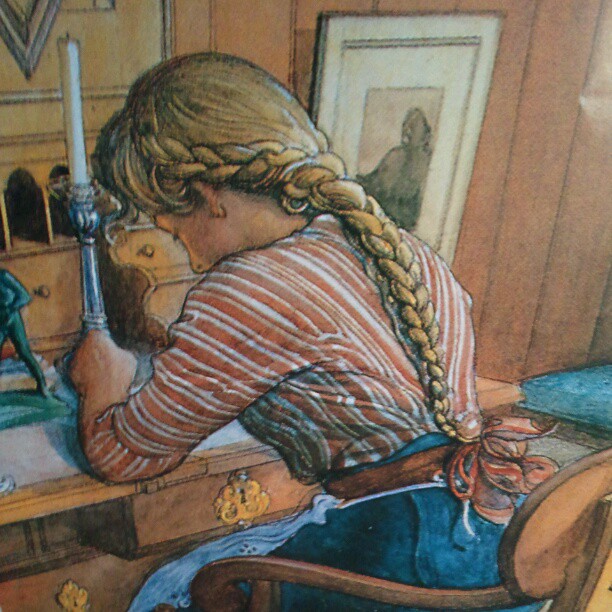
1) I like to pull out a bunch of our poetry books and let each kid (from Rose on down) pick one, and while I’m busy with something else, the kids each choose a poem to read to the rest of us. They enjoy the hunt, and I love hearing which poems have captured their hearts.
2) The Art Puzzle HD app. Another mom on my local homeschooling list mentioned it—we were sharing our favorites—and I love love love this app. You select a puzzle from paintings by artists like Van Gogh, Klimt, Bruegel*, Picasso, Renoir, and Dali. (More paintings are available via in-app purchase.) There are four levels of complexity and I’m finding even the second-easiest level to be challenging in some of these pieces—all Monet’s little dabs of color make for a puzzling puzzle indeed. There’s a gentle soundtrack of classical music (limited in repertoire but lovely choices—The Four Seasons, Beethoven’s Pastoral Symphony, Clair de Lune, the Elgar cello concerto I love—things I’m happy to listen to over and over, and am happy to have my kids hear). You can toggle the music off whenever you like. If you like (or wanted to like but the kids’ interest flagged) Mommy, That’s a Renoir, you’ll like this app. Best picture study resource I’ve seen in a long time. My only complaint is: no Carl Larsson!
*Wikipedia tells me he dropped the H from his name at some point. Who knew?
3) Earworms continues to be a hit with my older girls. Rose and Bean are nearly done with German Volume 2 now. Rilla and Huck have picked up a lot along the way. Jane is enjoying the Japanese version.
4) A liberal dose of fairy tales and nursery rhymes for my younger set. Nothing new here, just noting it because it’s bringing me so much joy these days.
5) Winter Holiday as a read-aloud. Though I do still hanker after the Gabriel Woolf audio recordings that Alice’s gang fell in love with ages ago. (Scroll down to the final comment on that post—hilarious!)
6) Sunday family Shakespeare readings. Still working our way through The Tempest. Sunday can’t come fast enough.
Remember when you ordered that gorgeous set of maps to go with the Holling C. Holling books? You know, the ones on printed creamy cardstock, ready and waiting for the giant set of Prismacolor pencils you got for a steal at Timberdoodle? And your oldest child dutifully filled in about half of Paddle-to-the-Sea’s route before everyone’s interest wandered elsewhere (a new set of timeline stickers arrived, most likely), leaving the poor little canoe to spend the next decade bobbing in the middle of the lake that looks like a pickle?
Yeah, that set of maps.
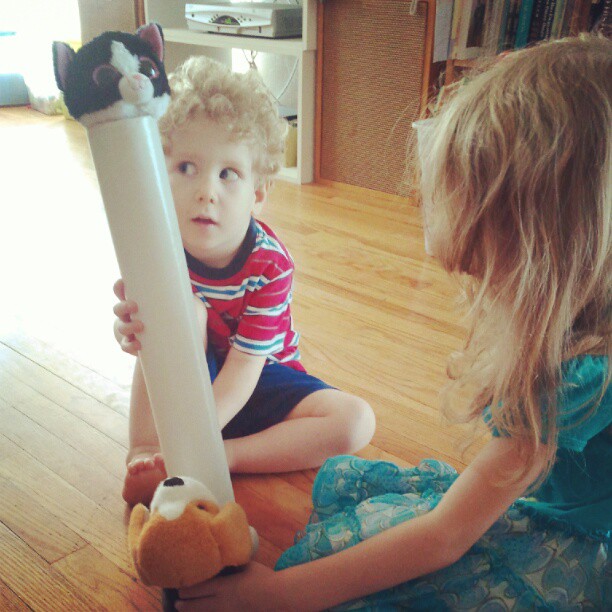
Your youngest children want you to know they really appreciate the purchase. That sturdy cardboard storage tube totally lives up to its marketing copy.
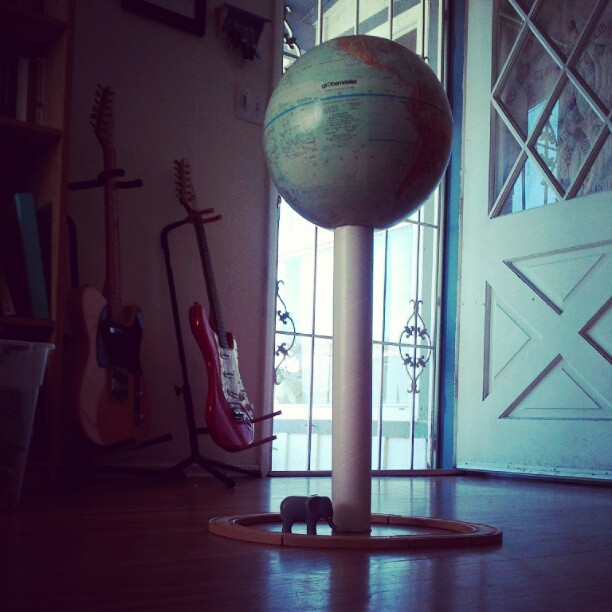
If you’re looking for the maps, they’re under the old Brio train table covered in Cuisenaire rods.

A momentous occasion today: Rilla’s first official high-tide morning. Of course she’s been swept along in the family currents her whole life, but today was special. I went around the house pulling out all the good old books I read with her sisters at her age: Just So Stories (she’s heard a few already), The Blue Fairy Book, Fifty Famous Stories Retold, the James Herriot Treasury for Children. Such happy memories these tomes call up! We began with D’Aulaire’s Leif the Lucky: I knew she’d like the art. And the map. She asked for the globe, which came apart from its stand last year, and cuddled it on her lap while I read, stopping me so she could trace Eric the Red’s path from Norway to Iceland to Greenland with her finger. “Whoa, three MILES, Mommy.” It took me back to our Mr. Putty days. He may have to be resurrected.
Of course, I read stories to her every day of the week, and there’s no reason other than family tradition to call this morning’s read-aloud “high tide.” But it’s a dear tradition to us and she was beaming her gappy six-year-old grin at taking her place in the spotlight.
I used to waffle about methodologies: was I a Charlotte Mason homeschooler? An unschooler? Something in between—eclectic, perhaps? But it was all just groping for a label—and not even a label for my kids; it was about how to characterize myself in conversations with other homeschoolers, so that we might better understand one another. All the while, my kids and I went on simply doing what worked for us. If something stopped working, we did something else for a while—usually this has meant facilitating a child’s need to immerse deeply into a single passion or pursuit. I grok that; it’s how I love to learn, too. This blog is a chronicle of my own sudden immersions, some of them finite, some recurring at intervals: breadbaking, gardening, sewing, Irish pennywhistle, British period drama…it’s a long list. My kids have lists of their own, each one different, some interests overlapping.
Always, always, after one of these immersions, the diver comes up for air eventually. And there’s a restlessness, a pacing at loose ends, that has, for us, always been cured by a return to morning lesson time. Rose has told me she likes having the structure there to push against: knowing there are things she is expected to do fills her with ideas for things she longs to do. One of my jobs is to keep ears open for the longings, and drop resources and opportunities in her path to help her realize them. I love that part of the job.
I love this part, the high-tide part, too. Rilla, an extroverted child, delivered her first narration with glee. I explained that some mornings, one of her sisters will read her a story, and she’ll come tell me all about it.
“That’ll be my favorite part,” she said, matter-of-factly.
Some days, it will.
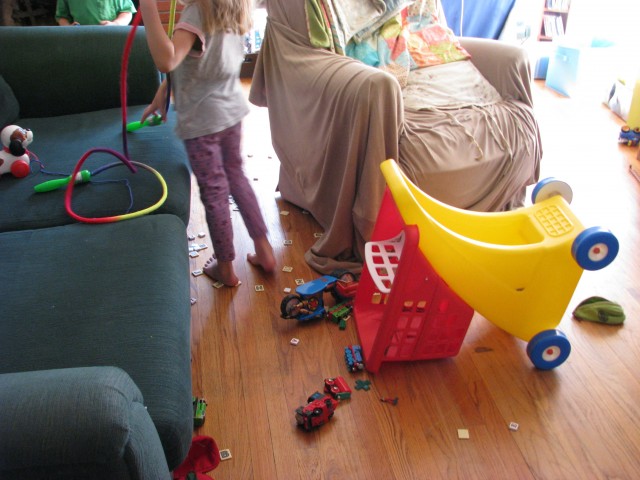
What the house looks like after a high-tide morning.
.jpg?picon=1621)
By:
DIANE SMITH,
on 9/1/2012
Blog:
DIANE SMITH: Illo Talk
(
Login to Add to MyJacketFlap)
JacketFlap tags:
homeschooling,
mural,
panels,
memorial,
Horizons,
CoOp,
varnish,
Robert Smith,
primer,
tackiness,
Add a tag
...screamed my daughter.
 |
| Now you see it - now you don't! |
No, I've turned all of the panels around and I am currently painting a couple coats of clear varnish on the backsides. I wanted to do the backs first because I wasn't sure how tacky it would be for and for how long. The primer we used seemed to always have a certain degree of tackiness - even at this point. If that was to be the case with the varnish, then I wanted to do the fronts last and make sure they didn't lean up against anything while they awaited transportation.
I've now discovered that the varnish dries quickly and the finish isn't tacky at all. Good! Now, I plan to put the panels one at a time on sawhorses and paint a couple coats on the fronts and all edges.
 |
| In Loving Memory... |
 |
| Past Horizons Group During Some Outdoor Activities |
I had really hoped to be done by now - I feel like things have been moving at a snails pace. Of course, we have since had the memorial for my father-in-law,
Robert Smith, and will soon be doing much to care for my mother-in-law as we are the only relatives in the area. We're also 2 1/2 weeks into our school year, now - so far so good! I have an 8th grader, a 5th grader, and a preschooler this year. Also, we'll be starting our multi-family, multi-subject co-op called
Horizons on Tuesday. I've had A LOT of communication, organization, supplies, and general loose-ends to tie up. So, I will be "laboring" on that this Labor Day Weekend.
Still, God is great and life is good! Just keep plugging away...
The always wonderful Handmade Homeschool on the dearth of blogs focusing on the details of homeschooling through high school:
I would like to see older homeschoolers represented online with the same enthusiasm. Why? Well, because I’d like to have my reality reflected, too. I’d like to be inspired. I’d like to be reassured. And if it was a slightly more glamorous image than reality, my heart would welcome that, too. A little salesmanship of the day-to-day. Calgon, take me away…
Lets do better. I’m busy. So are you. It’s harder to find the anecdote, perhaps, or to remember to pass it along. But we owe it to ourselves to memorialize this homeschooling stage as well as we did in the cuter years, and we owe it to each other.
(Read her whole post.)
I posted this link on my Facebook page and it sparked a thoughtful conversation, and I thought I’d share it here too. Our FB discussion centered on the difficulty of protecting and respecting the privacy of our older kids—their stories are their stories—while acknowledging that many of us do crave the experience-sharing and resource-sharing we enjoyed in our homeschooling blog circles and discussion boards when all our children were small. It’s a line I’ve walked cautiously here. I’ve often written about my decision to blog less about my older children as they’ve moved into their tween and teen years. (Metadiscussion junkie that I am.)
At the same time, I’ve missed it, the long education-philosophy chats* and the nitty-gritty resource-sharing. (Education philosophy and resource-sharing junkie that I am.) I don’t know how one threads that needle—respecting kids’ privacy while blogging freely about the thoughts and activities that occupy our days—and I always enjoy a peek into others’ homeschooling lives.
What do you think? Where’s the sweet spot on that fine line?
(UPDATE: My FB friend Angela chimed in with a link to a brand-new blog, hilariously titled Homeschooling Mother Clucker, that aims to find that sweet spot. I’m thrilled. I’ve missed Mother Crone.)
*While it’s true I’ve missed the ed-method threads that dominated the early years of this blog, around four years ago I deliberately dialed down my musings in that direction, in part because once I found my groove, my whole tidal homeschooling thing, I didn’t need to think out loud quite so intensely; and also because I ran out of energy and time for the occasions where the discussion turned to debate. We found what fits our family culture and I didn’t have any desire to proselytize nor defend it; it simply was what it was, is what it is, an ebbing and flowing rhythm of structure and freedom that suits us. We shift gears so often I can’t begin to tell someone else how to drive.  And lots of times, “thinking aloud” comes across as opining. I’m keenly aware that every family is different (even different from itself, season to season), and school works best for some, and unschooling works best for some, and rigorous classical ed works best for some, and a messy hodgepodge works best for others. One of my favorite comments I’ve ever received on this blog was from Bonny Glen reader Sashwee, who remarked (in my post about comics making you smart): “Th
And lots of times, “thinking aloud” comes across as opining. I’m keenly aware that every family is different (even different from itself, season to season), and school works best for some, and unschooling works best for some, and rigorous classical ed works best for some, and a messy hodgepodge works best for others. One of my favorite comments I’ve ever received on this blog was from Bonny Glen reader Sashwee, who remarked (in my post about comics making you smart): “Th
“After breakfast,” she went on, “you must have a look at Daisy and the rest of the garden. Then we’d better do some lessons.”
“In magic?” I asked. I was both curious and scared.
Juniper laughed.
“I thought we’d begin with reading, writing, astronomy, fairy stories—that kind of thing. Later on we’ll do a bit of Latin.”
“Girls don’t learn Latin,” I told her. “It unfits them for marriage.” (I was quoting my Uncle Gregor’s views on the education of girls.) “And I never heard of a school that taught fairy tales.”
“All learned people learn Latin,” she said. “It’s bound to come in useful. Fairy tales, on the other hand, are about real life.”
—from Wise Child by Monica Furlong
I first read Wise Child in 1993—I remember because my boss at Random House was Monica Furlong’s editor on Robin’s Country, and everyone there said ‘Oh you’ve got to read her other books, they’re wonderful,’ and they were right. That was before I had children, before I’d ever heard of homeschooling, much less considered doing it. So I’m amused, now, to find that what I’ve been doing all along is really Juniper’s version of education. Minus the good cow, Daisy.

By:
admin,
on 5/28/2012
Blog:
Litland.com Reviews!
(
Login to Add to MyJacketFlap)
JacketFlap tags:
teach,
book of the day,
Orthodox,
gifted,
generations,
raising children,
virtues,
priest,
advanced reader interest,
authors & guests,
Summer/vacation reading,
ethics/morality,
teachers/librarians,
single parenting,
Book of the Day!,
classroom ethics,
Visitation,
Annunciation,
Catherine Hickem,
death of child,
disabled child,
Hickem,
Marian,
review,
ya,
teens,
children's books,
book reviews,
reading,
family,
vacation,
kids,
history,
book,
literature,
young adult,
book review,
young adults,
summer,
Adults,
Christmas,
God,
teaching,
education,
children's,
non-fiction,
motherhood,
character,
homeschooling,
parenting,
bible,
Jesus,
homeschool,
holiday,
teen,
grief,
loss,
psychology,
disabled,
therapy,
mothers,
birth,
bedtime stories,
Christian,
children's lit,
reflection,
character education,
Mary,
gifted education,
book club,
mothers day,
new release,
Evangelical,
morals,
Memorial Day,
Catholic,
bible stories,
psychotherapy,
reader,
Add a tag
 Hickem, Catherine. (2012). Heaven in Her Arms: Why God Chose Mary to Raise His Son and What It Means for You. Nashville, TN: Thomas Nelson. ISBN 978-1-4002-0036-8.
Hickem, Catherine. (2012). Heaven in Her Arms: Why God Chose Mary to Raise His Son and What It Means for You. Nashville, TN: Thomas Nelson. ISBN 978-1-4002-0036-8.
What do we know of Mary?
What we know of Mary’s family is that she is of the house of David; it is from her lineage Jesus fulfilled the prophecy. Given the archeological ruins of the various places thought to have been living quarters for their family, it is likely the home was a room out from which sleeping quarters (cells) branched. As Mary and her mother Anne would be busy maintaining the household, with young Mary working at her mother’s command, it is likely Anne would be nearby or in the same room during the Annunciation. Thus Mary would not have had a scandalous secret to later share with her parents but, rather, a miraculous supernatural experience, the salvific meaning of which her Holy parents would understand and possibly even witnessed.
Mary and Joseph were betrothed, not engaged. They were already married, likely in the form of a marriage contract, but the marriage had not yet been “consummated”. This is why he was going to divorce her when he learned of the pregnancy. If it were a mere engagement, he would have broken it off without too much scandal.
Married but not yet joined with her husband, her mother would prepare her by teaching her all that she needed to know. This is further reason to assume that Mary would be working diligently under her mother’s eye when the Annunciation took place.
We know that her cousin Elizabeth’s pregnancy was kept in secret for five months, and not made known until the sixth month when the Angel Gabriel proclaimed it to Mary. We know Mary then rushed to be at her elderly cousin’s side for three months (the remaining duration of Elizabeth’s pregnancy), and that this rushing appeared to be in response to Elizabeth’s pregnancy (to congratulate her), not an attempt to hide Mary’s pregnancy. Note how all of this is connected to Elizabeth’s pregnancy rather than Mary’s circumstances. As Mary was married to Joseph, he likely would have been informed of the trip. Had the intent been to hide Mary, she would have remained with Elizabeth until Jesus was born, not returned to her family after the first trimester, which is just about the time that her pregnancy was visible and obvious.
So we these misconceptions clarified, we can put Mary’s example within an even deeper context and more fully relate to her experience. We can imagine living in a faith-filled family who raises their child in strict accordance of God’s word. The extended family members may not understand, and certainly their community will not, so Mary, Anne and Joachim, and Joseph face extreme scandal as well as possible action from Jewish authorities. But they faced this together steep in conversation with God, providing a model for today’s family.
Although sometimes scriptural interpretations are flavored with modern-day eye, overall this book will be more than just a quick read for a young mother (or new bride, or teen aspiring to overcome the challenges of American culture, or single parent losing her mind). It is a heartwarming reflection with many examples that open up conversation with God. As an experienced psychotherapist, the author’s examples are spot on and easy to relate to. We do not need to have had the same experiences to empathize, reflect, and pursue meaning; we see it around us in everyday life. As such, a reflective look upon these examples can help one overcome an impasse in their own relationship with God and also open the reader up to self-knowledge as Hi

By:
admin,
on 5/20/2012
Blog:
Litland.com Reviews!
(
Login to Add to MyJacketFlap)
JacketFlap tags:
review,
ya,
middle reader,
teens,
children's books,
book reviews,
science fiction,
reading,
family,
vacation,
kids,
history,
adventure,
book,
literature,
fiction,
young adult,
book review,
young adults,
summer,
Adults,
God,
teaching,
children's,
historical fiction,
fantasy,
non-fiction,
romance,
Mystery,
character,
homeschooling,
bible,
homeschool,
holiday,
tween,
teen,
bedtime stories,
Christian,
children's lit,
anthology,
character education,
Roman,
book club,
new release,
young readers,
morals,
Farm animals,
39 clues,
sci fi,
Memorial Day,
Catholic,
reader,
early reader,
teach,
book of the day,
Chesterton,
generations,
middle readers,
virtues,
WhitSunday,
priest,
advanced reader interest,
space ship,
authors & guests,
Summer/vacation reading,
ethics/morality,
teachers/librarians,
science or nature,
Book of the Day!,
classroom ethics,
father’s day,
mother’s day,
Pentacost,
Shavout,
Add a tag

BOOK OF THE DAY-June
Plan in advance for father’s day! The month of June is dedicated to books for dads and boys…don’t worry, a few dads & daughter books thrown in too! Good list for reluctant readers as well as summer vacation. Enjoy!

By:
admin,
on 5/20/2012
Blog:
Litland.com Reviews!
(
Login to Add to MyJacketFlap)
JacketFlap tags:
review,
ya,
middle reader,
children's books,
science fiction,
reading,
family,
vacation,
kids,
literature,
fiction,
young adult,
young adults,
summer,
God,
teaching,
children's,
romance,
homeschool,
holiday,
tween,
teen,
children's lit,
character education,
morals,
Farm animals,
reader,
early reader,
teach,
Chesterton,
virtues,
priest,
space ship,
classroom ethics,
teens,
book reviews,
history,
adventure,
book,
book review,
Adults,
historical fiction,
fantasy,
non-fiction,
Mystery,
character,
homeschooling,
bible,
bedtime stories,
Christian,
anthology,
Roman,
book club,
new release,
young readers,
sci fi,
Catholic,
book of the day,
generations,
middle readers,
advanced reader interest,
authors & guests,
Summer/vacation reading,
ethics/morality,
teachers/librarians,
science or nature,
Book of the Day!,
Add a tag
BOOK OF THE DAY-May
In celebration of Mother’s day, moms, women and daughters, recommendations span ages and areas of interest. Great for summer vacation reading too!
American Libraries recently posted an article about programming for homeschooled kids and their families. There are a lot of great ideas there that you should take a look at, but very few of the ideas are focused on teens. Like any library media specialist knows, teens need to have their reading, research, and library skills in check before college, and those being homeschooled are no different.
In addition to inviting those teens to your regular programming and events, consider doing things for them during the lull of the day, when everyone else is in school. Not all parents who homeschool are necessarily schooled in how to use library databases, scholarly journals, and online media for research projects, so perhaps a small group might appreciate a workshop similar to the ones high school students get from their librarians. You could even designate a special hour a week for drop-in lessons.
On a similar note, homeschools don’t employ full-time college counselors, but you probably have a circulating and non-circulating collection of test prep books, college guides, and more. Another unique daytime program you can offer, then, is a college workshop. Invite some current college students, whose schedules also allow them to have some free hours during the day, to answer questions about local schools and essay topics, and see if any of your regular homework tutors can volunteer to come in and help with the process.
Many homeschooled kids participate in things like Cub Scouts, community theatre, and sports so that they’re not cut off from the greater community. But what about that good ol’ teen stuff that your parents aren’t supposed to facilitate for you? You know…angst, sex, peer pressure, body changes. Consider hosting a daytime talk group, possibly broken into male- and female-only groups, where peer mentoring and bonding can happen outside of the home and away from the parents. This is also a great way to look into partnering with community organizations dedicated to youth development or prevention, or to bring in a volunteer or intern, such as a graduate student in counseling. To broaden horizons even more, make it a drop-in after-school talk, where teens from any school situation can hang out. Write a theme on a whiteboard outside the door, alongside some guidelines for safe spaces, and let them guide the conversation the way they would at lunchtime on the bleachers.
Many homeschooling parents form support or social groups. Look online for groups in your area, and then reach out to them to let them know about the resources you already have. Since they’re apt to take their kids on field trips, remind them about the museum passes you offer. Put them on a mailing list and let them know about new materials in the library relevant to curriculum and enrichment. Send them a schedule of all the events for teens, but highlight those that are designed specifically for homeschoolers. Or reach out and ask the parents and the teens what they’d like to see in their library.
Host an alternative futures event! If local high schools are only doing traditional college fairs, work with representatives from the Peace Corps, Americorps, and other post-graduation, gap year programs. While any teen would enjoy programming such as this, it’s especially relevant to more and more homeschooled teens, who often decide against college or the military post “graduation” in favor of more self-paced, experiential learning like they’re used to. This would be a great way to spark conversation between your homeschooled patrons and their traditional school counterparts–what do they think are the best plans for an 18-year-old? What could they never see themselves doing?
Do you have a strong contingent of homeschooled teens in your community? Do you even know?
View Next 25 Posts



















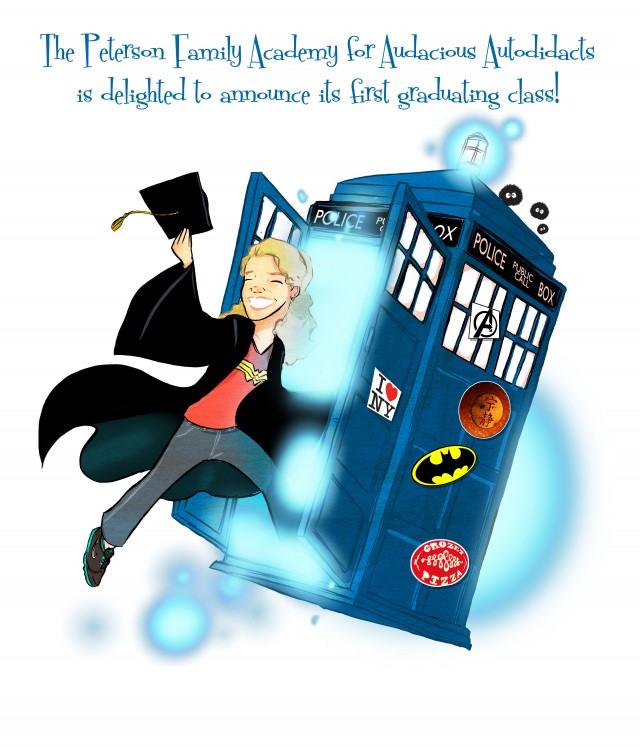








Donna,
Such passion! Such drive! Such lucky children! You’re definitely on a mission and you should feel very good about it. Thanks for sharing your take on homeschooling and general information about its accountability piece.
I say “ditto” to everything Linda says. You are equipping those kids to be the people God wants them to be.
Jean
Thanks for sharing! We are now in our 18th year of homeschooling in NC and still loving it! While there are many misconceptions about homeschooling (especially the old socialization thing), I think that today there are fewer misconceptions by the general public than there used to be. Homeschooling is going mainstream! When we first started and would go out to the park or store during the day, we’d often be questioned as to why the kids weren’t in school. I’d say it’s been about 10 years now since we’ve had anyone question us while we were out during a school day. I remember our relatives expressing concern early on and we tried to honestly and sincerely answer their questions. They had our kids’ best interests at heart and so did we; they deserved thoughtful answers. I always thought to myself, “The proof is in the pudding.” Once our two oldest graduated from college (one with a 4.0, triple majoring in engineering) they didn’t ask anymore questions! BUT, the high academic standards were not the main reason we chose to home school. We chose homeschooling because we thought it was the best way we knew to teach them what God tells us to teach them.
I really appreciate you — you’re such an encourager!
thank you for sharing, too! The proof is in the pudding… I like that!
Thank you, my friend. I am trusting in His provision and grace!